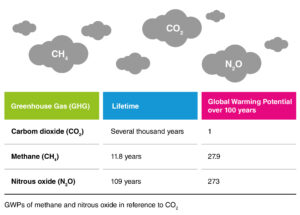The Garden Division of FITT announces its entry into Make It Zero, a global initiative launched by EDRA/GHIN to tackle greenhouse gas emissions in the DIY sector. With a particular focus on Scope 3 emissions, Make It Zero aims to mobilize the global value chain to collaborate and expand decarbonization efforts. Shared goals and commitment […]
Greenhouse Gas Emissions: From Warming Potential to Organizational Carbon Footprint
Greenhouse gases are gases that trap heat in the atmosphere: they act like a blanket insulating the Earth, absorbing solar energy, and slowing its escape back into space.
In 1997, the Kyoto Protocol, the first instrument designed to set reduction obligations, identified 6 main gases that contribute to the greenhouse effect (Greenhouse Gases – GHG): carbon dioxide (CO2), methane (CH4), nitrous oxide (N2O), hydrofluorocarbons (HFCs), perfluorocarbons (PFCs), and sulphur hexafluoride (SF6).
Global Warming Potential of Greenhouse Gases
Greenhouse gases differ in two key aspects: radiative efficiency, which is the capacity to absorb energy, and lifespan, or how long they stay in the atmosphere. The Global Warming Potential (GWP) is a scientific metric that determines these two factors.
The GWP allows a direct comparison of the impact of different greenhouse gases on the Earth’s warming relative to CO2. Carbon dioxide is the reference gas, with a GWP of 1 over 100 years, as it has a very long atmospheric lifespan, potentially lasting thousands of years.
Three time periods are used for GWP calculations: 20 (GWP20), 100 (GWP100), and 500 years (GWP500).
Below is a comparison of the emissions of CO2, methane, and nitrous oxide, the greenhouse gases with the most significant impact on climate change.

While methane remains in the atmosphere for just over a decade and nitrous oxide for about 120 years, CO2 can stay in the atmosphere for up to 1000 years.
Methane has a GWP of 28, meaning that an amount of methane released into the air is 28 times more polluting than the same amount of CO2.
The higher the GWP index value, the greater the impact of the gas on global warming.
From GWP to Carbon Footprint Calculation
Greenhouse gases are the primary cause of the rise in global temperature, each in relation to its GWP.
The first step in combating climate change is to measure the carbon footprint. This is an indicator that estimates the amount of GHG emissions generated directly or indirectly by a product, service, organization, or individual.
The carbon footprint analysis is regulated by the UNI EN ISO 14000 series, which establishes the requirements and measurement parameters in accordance with the LCA (Life Cycle Assessment) method.
FITT has obtained certifications for both the systematic approach to product carbon footprint (ISO 14067 – Systematic Approach) and for the organization’s carbon footprint (ISO 14064).